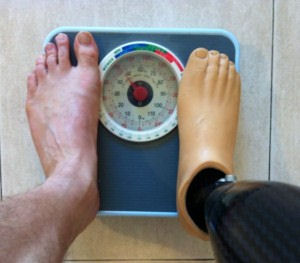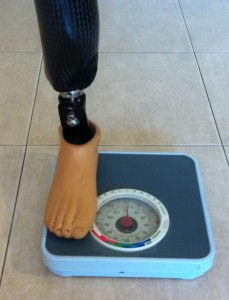 Recently, I’ve seen people raising the question about the “true” weight of amputees. In an attempt to calculate their BMI, they ran into the question: “what would be the weight of my missing leg/arm?”, “how can I estimate my total body weight, had I not been amputated?” When I saw someone apologizing for asking such a “stupid” question, I decided to look for an answer. Remember, when it comes to the quality of life of the amputee, there are no stupid questions.
Recently, I’ve seen people raising the question about the “true” weight of amputees. In an attempt to calculate their BMI, they ran into the question: “what would be the weight of my missing leg/arm?”, “how can I estimate my total body weight, had I not been amputated?” When I saw someone apologizing for asking such a “stupid” question, I decided to look for an answer. Remember, when it comes to the quality of life of the amputee, there are no stupid questions.
Weight of Limb Segments
The table below lists the weight of the human body limb segments as weight percentage of the total body weight. Data are taken from a scientific paper published at the Journal of Biomechanics by DeLeva on 1996 [1].
|
|
Upper Arm |
Forearm |
Hand |
Thigh |
Leg |
Foot |
|
Women |
2.55 |
1.38 |
0.56 |
14.78 |
4.81 |
1.29 |
|
Men |
2.71 |
1.62 |
0.61 |
14.16 |
4.33 |
1.37 |
Table 1. Weight of limb segments (percentage of total body weight)
Note that values for limb segments weight represent a statistical average and that all individuals exhibit some deviations from the average in their proportions between body segments. Also note that there is a clear difference in limb segment weight between women and men. It is not surprising to see that the average arm, hand and foot of the average man weighs more than these same limb segments in a woman’s body (relative to the total body weight).
How should we read these data? Since the weight of a limb segment is given in percentage of the body weight, we have to take the data entry of interest, multiply by the body weight and divide by 100. For example, the weight of the forearm of a man weighing 92 Kg would be 1.62×92/100 namely, 1.49 Kg. The weight of the thigh of a woman weighing 130 pounds would be 14.78×130/100 namely, 19.2 pounds.
Weight of an Amputated Limb
 Let us now continue to calculate the weight of the amputated limb. For a below-knee leg amputee, this would mean adding the weight of the foot to the weight of the missing section of the leg. An above-elbow arm amputee would have to add the weights of the hand, the forearm and the missing part of the upper arm. In such calculations we ignore the basic conical structure of our limbs and assume that each limb segment is a cylinder of uniform diameter.
Let us now continue to calculate the weight of the amputated limb. For a below-knee leg amputee, this would mean adding the weight of the foot to the weight of the missing section of the leg. An above-elbow arm amputee would have to add the weights of the hand, the forearm and the missing part of the upper arm. In such calculations we ignore the basic conical structure of our limbs and assume that each limb segment is a cylinder of uniform diameter.
To make it clear, let’s look into the following case examples:
- Man, below-knee amputee, approximately 3/4 of the leg amputated – in this case we will add up the weight of the foot (1.37) and three quarters of the leg (0.75×4.33). The resulting weight percentage is 4.62%. Therefore, a man weighing 165 pounds will lose 7.62 pounds following a 3/4 leg, below-knee amputation.
- Woman, above-knee amputee, approximately half the thigh amputated – here we add the weight of the foot (1.29), the full weight of the leg (4.81) and half the weight of the thigh (0.5×14.78). The resulting weight percentage is 13.5%. Therefore, a woman weighing 58 Kg will lose 7.83 Kg following a half-thigh, above-knee amputation.
- Woman, below-elbow amputee, approximately 2/3 of the forearm amputated – we add the weight of the hand (0.56) and two thirds of the forearm (0.67×1.38). The resulting weight percentage is approximately 1.5%. Therefore, a woman weighing 140 pounds will lose 2.1 pounds following such a below elbow amputation.
- Man, above-elbow amputee, approximately quarter upper arm amputated – we add the weight of the hand (0.61), the full weight of the forearm (1.62) and quarter the weight of the upper arm (0.25×2.71). The resulting weight percentage is 2.9%. Therefore, a woman weighing 200 pounds will lose 5.8 Kg following such an above elbow amputation.
BMI Calculations for Amputees
To calculate the Body Mass Index (BMI) of an amputee, we first need to know the “true” body weight of the amputee i.e. the body weight had he/she not been amputated. After obtaining the weight of the amputated limb as explained in the above paragraph, we may proceed to calculate the “true” body weight of the amputee. This will be given by:
So, if an amputee has lost 3% of his/her body weight as a result of the amputation, the “true” body weight would be the present weight times 100 divided by 97. 5% weight loss due to amputation means a “true” weight of 100/95 times the present weight, etc.
To further calculate the Body Mass Index (BMI) of an amputee, we need to take the result obtained for the “true” body weight and plug it in the BMI formula:
Note the 703 conversion factor between the UK and US unit systems.
Seems complicated? Having trouble calculating your “amputee BMI”, your “true” weight, or your weight loss due to your amputation? Don’t be shy. Ask us below and we’d be happy to help. If we receive enough requests, we’d consider creating an automatic calculator to calculate the weigth of your lost limb and your BMI.
